 Days of Wonder is a big name in the board game business. Publisher of incredibly successful entry-level games like Ticket to Ride, Small World, and Memoir ’44, almost everyone has played something from Days of Wonder. Not only are their games easy to get into, but they are filled with beautiful and well-made components.
Days of Wonder is a big name in the board game business. Publisher of incredibly successful entry-level games like Ticket to Ride, Small World, and Memoir ’44, almost everyone has played something from Days of Wonder. Not only are their games easy to get into, but they are filled with beautiful and well-made components.
Five Tribes is being touted as Days of Wonder’s first “gamer’s game.” They have teamed up with Bruno Cathala; designer of Cyclades, Mr. Jack, Abyss, and many others. The result of this sort of Dream Team is a well designed, easy to play, hard to master, strategy game.
Five Tribes is a game for 2-4 players and plays in about 60 minutes. Five Tribes plays best with any number of players.
Game Overview:
Five Tribes takes place in the fabled Sultanate of Naqala. Players move meeples, representing the Five Tribes, to gain power and influence. The movement has often been referred to as “Mancala-like”. Players remove all meeples from a tile and distribute them one at a time, moving orthogonally. At the end of the game, whoever has accumulated the most influence and wealth will become the new ruler of Naqala.
Components:
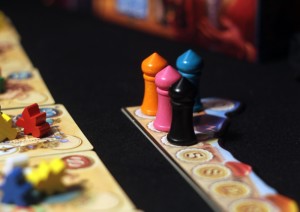
As I alluded to already, Days of Wonder is known for quality games, and Five Tribes is no different. Setup consists of randomly placing the modular board, which consists of 30 double-sided tiles. Then meeples are drawn randomly out of an included cloth bag to start the game.
The best components are the remaining wooden bits; camels in each player’s color, palm trees, and palaces. There just aren’t any corners cut. Many of these pieces could be cardboard chits, but instead are beautiful, thick wooden pieces. Even the player bid markers are large wooden spires.
If there is any negative, the art is a little cartoon-like for my tastes. Its well drawn, but doesn’t really do much to draw you into the world. But let’s just get it out-of-the-way here, this is a eurogame, theme isn’t really what it’s about.
How To Play:
Every round of Five Tribes starts with an auction. Players bid for turn order, any amount from 0 to 18 gold coins. Each gold coin is essentially a victory point, so over bidding has significant risks. The player who went first the previous round will bid first the next round. The real key to the auction element is how bidding zero works. The first player to bid zero will always go last. The next player to bid zero will take their turn ahead of each other player who chose not to pay to play.
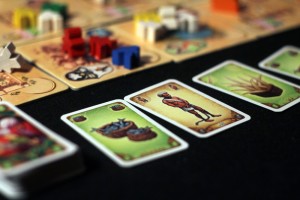
Once turn order is worked out, each player removes all meeples from one tile. Then, starting on an adjacent tile, drop meeples one at a time (one per tile). When the last meeple is placed, all meeples of that color are removed from the end tile. If the tile is now empty, the player puts a camel on it to claim that area. The tile you end on also has an action – sometimes mandatory like adding a palm tree or palace that increase the value of that area, or voluntary, like buying resources or Djinns.
The meeples you collect also have special abilities. Yellow viziers score basically as victory points, giving you a bonus if you have more than other players. White elders can also be victory points or used to buy Djinns that give a player a special ability. Blue builders score victory points based on the number of meeples collected and the number of nearby blue tiles. Green merchants allow you to collect resource cards. And finally, red assassins can remove meeples from nearby tiles on the board, or knock off some of your opponent’s viziers.
At the outset, there are tens or hundreds of possible legal moves. A move is only legal if you can end by dropping a meeple where a like-colored meeple already exists. As meeples are removed the board, the options become less diverse and players may be left with little to no profitable moves. Play continues until a player is out of camels or there are no legal moves remaining. Once that point is reached, points are tallied immediately and a winner is declared.
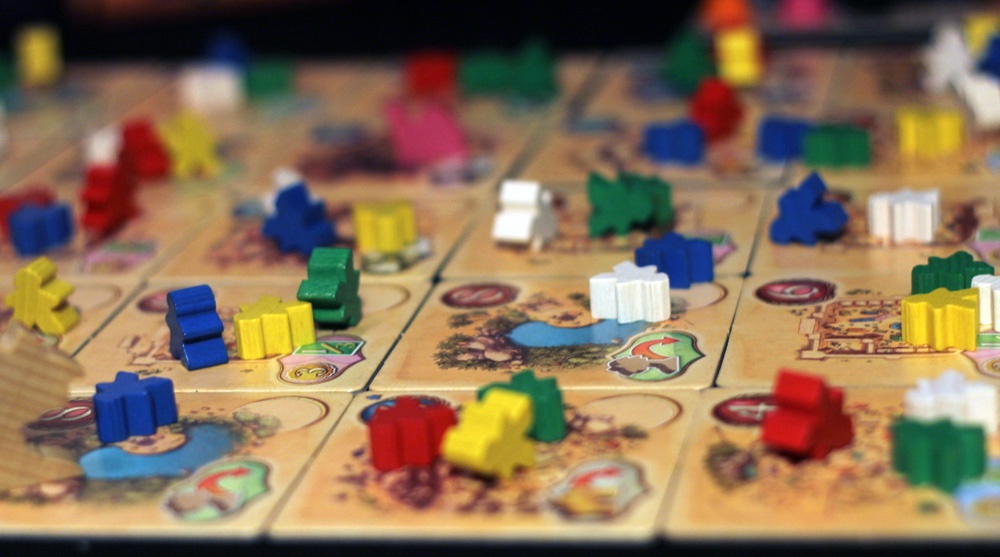
Game Experience:
Five Tribes is a medium-to-heavy weight eurogame, but doesn’t necessarily feel like. That may not sound like much, but I consider that to be extremely high praise. The rules are clear and its fairly easy to explain enough of the rules to get a new game underway within 10-15 minutes. There are plenty of ways to earn victory points, and most of all, the strategies seem viable. Games can be won off of the powers of really powerful Djinn abilities. But, just as often, games can be won by collecting viziers and resource cards to cash in.
The ability to see an opportunity and take advantage of it is often the difference between winning and dead last. Even without any catch-up mechanic, most games I’ve played have come out pretty close, but always in the favor of the player who seemed to make a couple really good decisions along the way.
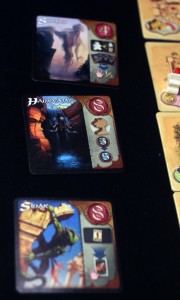
The auction element adds a layer of strategy to Five Tribes. If you have the last move in a particular round, you can leave open potentially rewarding options, knowing with the last bid, you can go first if you really want to pay for it. At the same time, bidding to go first may seem like a great idea, but after the first couple of players’ moves, the last player is staring at a whole new board which may have some even better possibilities open up. Or may leave nothing worthwhile at all.
Five Tribes strategy can go about as deep as you want it to. Most gamers I’ve played with approach it in a similar way; they evaluate the board to find the best place to drop off the last worker. However, if you pick up 5 meeples, you really have 4 decisions to make before that… which order are you dropping off those meeples? If you add another green to this tile, it may open up a move into resources for the next turn. Or if you leave a red assassin alone here, it’s going to let someone claim that tile later this round. Depending on your group – that level of decision-making can either be exhilarating or exhausting.
Analysis paralysis is a real problem for Five Tribes, we’ve often had to set some timers to keep the game moving along. Beware, AP-prone gamers, your head may explode! However, the payoff when you set yourself up for a great move or displace meeples in a way to block other players is worth it. I can’t think of any other game where I’ve felt such joy in making what at least seems to be an optimal move.
My biggest gripe with Five Tribes is the end-game. Because the restriction on what constitutes a legal move, nearly every game ends with everyone working together to see if the game is actually over or not. A minor gripe, but in a close game, the last thing I want to do is show my opponent how to score 5 more points before the game is officially over.
Finals Thoughts:
Five Tribes is exactly what Days of Wonder built it up to be, a gamer’s game. It’s a great game, well designed and really balanced. There are plenty of hard but rewarding decisions to make each game. Component quality leaves little to be desired and Five Tribes is a beautiful game to look at on the table.
Each play of Five Tribes is more rewarding than the last. Each game you pick up a bit more understanding of the possibilities that you can create. The modular board and random setup of meeples insures that no game is exactly like the last, the “best” strategy from game to game will assuredly be different. The meeple-displacement mechanic is unique and opens up a world of possibilities on turn one that whittles down to less and less options as the game goes on. While all the decisions to make may freeze up some players, its worth slogging through a play or two even with the most AP-prone gamers. Five Tribes will be hitting the table at my game night often for years to come.
If you’d like to treat yourself to a copy of this gem, you can grab a copy for about $50.
Final Score: 5 stars – A great, well-designed, unique strategy game. Days of Wonder hit a home run with their first “gamer’s game”.
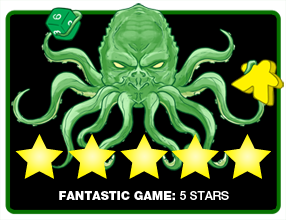 Hits:
Hits:
• Lots of roads to victory
• Random distribution and modular board increase replayability
• High quality components
• Easy to teach, hard to master
Misses:
• Theme is weak, artwork doesn’t add much to it
• Analysis paralysis can be crippling







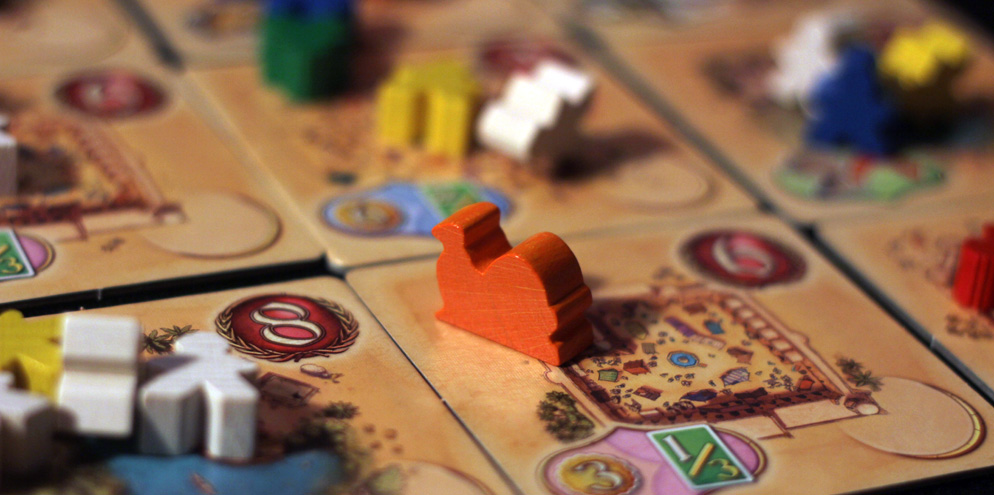















Five Tribes is my favorite strategy game. I never tell anyone who has played before *what* the last move is just that there *is* a last move.
Yeah, as I play this game with folks who are very familiar with the game it is less of a problem.